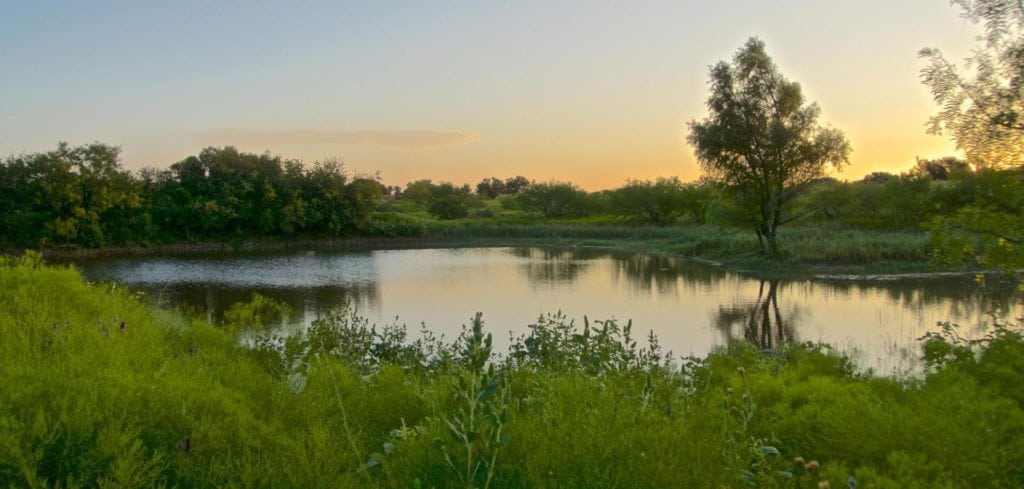Written by Ruben Cantu and Greg Simons, Wildlife Biologists | Wildlife Consultants, Inc.
Hunting enthusiasts often want to manage their land for white-tailed deer, quail and turkey. While it’s possible to have all three species thriving on one piece of property, it’s not possible to have the maximum number of each species thriving on the property. There is a subtle, but critical difference between optimizing habitat and maximizing habitat.
Maximizing habitat is exactly what it sounds like—maximizing the habitat for a single key species in order to maximize the numbers of that species. Optimizing habitat is the strategy used when a landowner wants to create the most suitable habitat for multiple species. To manage for multiple species, a land owner must strike a balance between the specific needs of the different animals.
Regardless of species, all animals need water, food and cover. Deer, quail and turkey are not exceptions. They, too, need these basics of life in different forms and different amounts.
Deer and turkey have closer habitat requirements than do deer and quail. Turkeys and quail, although both are game birds, differ in their needs for brush cover. For example, from a brush cover standpoint deer and turkey prefer about 30 percent or more brush cover, although turkeys also need large trees for roosting. Quail prefer no more than 30 percent brush cover.
On a large ranch, it is possible to manage for slightly different habitat types on different portions of the ranch, so one area might have habitat more suitable for white-tailed deer, another pasture might be managed with quail in mind and third portion might be optimized for turkey. On a smaller property, land owners must recognize that the ranges of various will overlap and manage the property so that each species will have an adequate amount of what it needs in the form it needs it.
WATER
Good deer habitat contains well-distributed and reliable sources of water, preferably at ground level. Land owner who run cattle on their property can meet the water needs of deer with the livestock water as long as the livestock water is well-distributed. If the primary water sources are troughs it is easy to create a “spill over” that provides water at ground level that can be used by wildlife.
Quail and turkey would do better with available ground water sources such as every half mile apart or less. These birds also utilize stored water in the green vegetation, the seeds and the insects that they eat.
As a matter of fact, most wildlife species can survive with very little surface water to drink. Survive yes, thrive no. To optimize habitat and species abundance, plentiful water is a key component.
FOOD
A variety of plants are utilized as a food source for all three species. Deer are primarily browsers, while turkeys and quail eat seeds and insects.
With that said, in many cases, the animals can utilize different parts of the same plants. For instance, hackberry is a common shrubby plant whose leaves and twig tips are readily eaten by deer. Quail and turkey both eat its seeds. Turkey can even use larger hackberry trees for roosts.
Another example is an Engelmann daisy. While quail and turkey eat its seeds and consume the insects commonly found on forbs, deer eat the leaves.
Many plants. Many parts. Many uses by many animals.
COVER
Cover, in the context of this article, comes in two forms: nesting cover and screening cover.
Nesting cover for quail and turkey is found primarily on grasslands. Generally, good nesting cover is predominantly bunch grasses such as little bluestem with enough of last year’s remnant vegetation standing to build their ground nests in. These grasslands, especially if they include shade, also provide bedding areas where does can hide fawns.
While grasslands are important, quail and turkey chicks need some bare ground so they can move around. If grasslands are too thick it impedes a chick’s ability to move about freely.
Screening cover can serve several purposes for deer. They not only provide browse and hiding places, but, depending on the brush species, can be used as thermal cover during harsh winter weather.
For quail, screening cover can be brush like that needed by deer. There are also some weeds like broomweed, croton, and ragweed have growth patterns that can provide suitable concealment from above but allow for easy movement below. And a bonus, these weeds attract lots of insects, very important for growing quail and turkey chicks.
Turkey always do well where there is screening cover leading to and from turkey roosts. The tallest trees on a property provide the prime roosting location. Turkey can use 20 different species of trees for roosts. Common roost trees include: pecan, soapberry, elm, oak, hackberry and even large mesquite depending on where the property is located in Texas.
FINAL THOUGHT
Managing for all white-tailed deer, quail and turkey is quite doable as long as long as landowners remember they can’t maximize the population of each species. The trade-off for having slightly lower populations of deer, quail and turkey is that the landscape will be more diverse, which will benefit a host of other species as well. With diversity comes greater stability within the ecosystem and a greater degree of sustainability of the resources.
To learn more about striking the balance necessary to optimize your habitat for several species, contact Wildlife Consultants at (325) 655-0877 or see our website at www.TheWildlifeConsultants.com.

